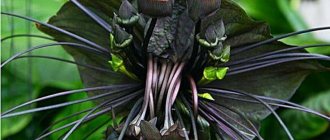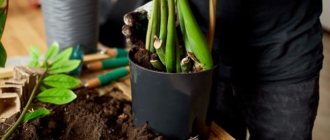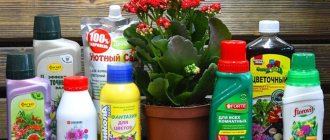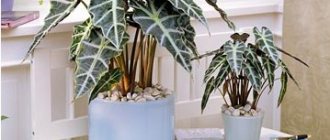Most flowerpots and pots with home flowers attract the attention of not only humans, but also curious cats. Unfortunately, not everything that cats are interested in is safe for them. Among the usual plants in the house there may be specimens that pose a mortal danger to pets.
Some blithely assume that animals intuitively or subconsciously know which houseplants are poisonous and which are not, in our case for cats. But in practice it happens differently. Pets suffer from poisoning of varying severity due to direct contact with poisonous parts of flowers. It is frivolous to assume that if a plant is considered medicinal for humans, for example, aloe vera is a frequent resident of window sills, then it does not pose any danger to cats. In this article we will examine in detail the question of which of the usual indoor plants are poisonous to cats.
Article continues after advertisement
List of dangerous plants and consequences
Poisonous indoor plants and flowers for cats are found in every third apartment, which pet owners are not aware of.
The final effect depends on the amount and type of active agent in the structure of the leaves or stem. This could be vomiting, fever, bowel dysfunction, or more serious problems. The eagerness of cats to gnaw flowers is not explained by increased interest or disobedience, but by cleansing the stomach of accumulated waste and toxins. The animal does not distinguish between useful and dangerous species, so the opposite effect often occurs.
There are several ways of infection. The most common is the consumption of leaves, flowers or stems of poisonous plants. Toxins also enter the stomach after drinking water from pot stands or eating soil. Particularly dangerous species infect an animal after physical contact with its fur or skin.
Flower shops rarely contain information regarding the toxicity of products, so before bringing a new plant into your pet’s home, find out in detail what effect it will have on the pet and all residents of the apartment.
The table groups the most common indoor plants that pose a threat to your pet.
| Name | What threatens |
| Geranium | Digestive disorder. |
| Evergreen boxwood | Serious intoxications, cases of death have been reported. |
| Azalea | Greens with bright flowers are fraught with danger - an alkaloid that is harmful to both cats and humans. If it enters the stomach, it depresses the central nervous system, provokes convulsions, swelling of the larynx, and disrupts the heart rhythm. |
| Cyclamen | If a leaf or stem gets into the stomach, it will end in vomiting, diarrhea, and abdominal pain. And if the kitten gets to the tubers, the risk of death is high. |
| Caladium | The leaves contain many dangerous acids, even a small amount of them leads to swelling of the larynx and chronic kidney dysfunction. But ingestion of juice is rarely observed due to its “burning” effect: when cats feel discomfort on their mucous membranes, they spit out the liquid. |
| Aloe | Aloe vera, which is healing for humans, belongs to the category of poisonous indoor plants and flowers for cats. Visually manifested as loss of coordination, lethargy, cramps, and diarrhea. |
| Anthurium | The poison is dangerous due to swelling of the mucous membranes and larynx. |
| Begonia | It acts in a similar way to the previous type, leading to burns of the mucous membranes and swelling of the oral cavity. Side effects are caused by the action of oxalic acid. |
| Hydrangea | Contains the most dangerous toxic substances - cyanides, which make breathing difficult, causing asphyxia. |
| Ivy | Decorative species are popular for decorating window sills, but are undesirable for cats - heart, kidney or pulmonary failure is guaranteed. |
| Sensevieria or pike tail | Allergic dermatitis. |
| Philodendron | Toxic substances contained in the leaves provoke swelling and have a detrimental effect on the kidneys. Burns to the mucous membranes after ingesting the juice are common. |
| Epipremnum aureus | Copious flow of saliva, swelling of the tongue and palate, pain in the stomach. |
| Asiatic lily | A toxic variety that causes vomiting, increased drowsiness, and loss of strength. Reduces appetite, provokes kidney failure. If you don't catch it in time, the animal may die. |
| Mother-in-law's tongue | Pain in all parts of the body, aches. Nausea, vomiting, stool upset. |
This is not a complete list of indoor plants harmful to cats, but all have similar side effects (swelling of the mucous membranes and larynx, diarrhea, vomiting, malaise, suffocation), the most dangerous ones being fatal.
The result will make itself felt after your cat tries one of the following plants:
- hippeastrum;
- zephyranthes;
- Eupharis;
- monstera;
- dieffenbachia;
- syngonium;
- oleander;
- mandevilla;
- Ardenia jasmine;
- Christmas Day;
- dracaena marginata;
- Usambara violet;
- peperomia, etc.
When poisonous houseplants and flowers for cats are discovered, remove them out of the cat's reach. If this is not possible, it is better to get rid of the plant. Be careful with calla lilies, sprenger ferns, crotons, and asparagus.
What other flowers should you stay away from?
Keep your kitten away from amaryllis, a poisonous flower; it causes convulsions, vomiting, increases salivation, and makes you feel depressing. The popular home flower Kalanchoe provokes dyspeptic disorders. After spathiphyllum, the mucous membranes become inflamed.
Schefflera will cause dermatitis on the skin, and euphorbia will cause conjunctivitis. The latter contains the potent poison euphorbine, which leads to nervous disorders and blindness.
For residents of the private sector whose pet loves to walk outside, it is important to know that trouble can also await them in their garden beds. Do not plant crocuses, pansies, calendula, oleander, daisies, poppies, tobacco, oregano, or dogwoods in your yard.
Instead, grow harmless asparagus officinalis, fittonia, basil, phlox, gerbera, lavender, and oregano. Decorate your yard (and at the same time nourish your cat's body with fiber, vitamins and minerals) by planting lovage, phalaenopsis, Russell's eustoma, passionflower, and Saintpaulia.
Signs of house plant poisoning
It often happens that there are both flowers and a cat in the house, but no one asks the question of the potential threat of the plant to the animal. The point at which this question arises is after the animal begins to show symptoms of an unspecified disease or has been observed eating plant parts.
Plants contain all kinds of biochemical substances in all their parts. These can be neurotoxins, abrasives, alkaloids, terpenoid saponins, cardiac glycosides, terpenes, lactones, pyrethrins and others. Each substance has its own effect on a living organism upon direct contact.
The most harmless thing that can happen, but which should alert the owner, is when the cat has eaten homemade flowers and begins to diarrhea or vomit . In many cases, such a reaction to plant poisoning will be strong, but then the unpleasant symptoms will stop spontaneously.
Article continues after advertisement
Signs of deadly poisoning from indoor flowers:
- breathing and heart rhythm disturbances;
- effects on the central nervous system, pathologies of a neurological nature;
- failure of filtering organs - liver, kidneys, spleen;
- bloody bowel movements or vomiting;
- coma, anaphylactic shock.
Signs of mild toxic poisoning from indoor plants:
- gastrointestinal manifestations (diarrhea, vomiting);
- local skin manifestations: redness, rash, swelling and swelling, ulceration;
- drowsiness, depression, apathy, refusal of food and water;
- abortion in pregnant cats;
- hypersalivation (increased salivation);
- deterioration or loss of vision.
If a cat has eaten flowers and is vomiting, you should immediately contact a veterinarian with complaints and provide information about the plant eaten, collect and provide vomit, and carry out antitoxic and symptomatic manipulations. Most often, the veterinarian will be able to stabilize the animal’s condition and make a full recovery.
The worst situation is with signs of damage to the vital systems of the body (central nervous system, cardiovascular, respiratory, hematopoietic, etc.). But only a veterinary specialist will be able to distinguish how dangerous these manifestations are in each specific case. The insidiousness of the most serious intoxications is that they can begin as a slight malaise.
Serious poisoning of cats from domestic flowers occurs unexpectedly for the owner. A number of factors contribute to this:
- the plant has potent substances;
- the animal is critically weakened, very young or, on the contrary, is of advanced age, and therefore reacts more strongly than others to poison;
- A large number of poisonous parts of the plant entered the cat’s body.
Are bouquets dangerous?
Having dealt with poisonous houseplants and cat flowers growing in pots on your windowsills, it’s worth noting that bouquets can also be dangerous. Lilies, chrysanthemums, tulips or lilies of the valley, once they enter the animal’s oral cavity, disrupt movement, cause dermatitis, and indigestion.
The leaves and roots of irises provoke vomiting and diarrhea, and hyacinths contribute to the development of heart failure. Snowdrops cause allergies, stomach upset, and if a large amount of the plant enters the body, cardiac arrest.
Daffodils are characterized by diarrhea, vomiting, kidney and heart failure (bulbs, leaves and flower stalks are especially dangerous for cats). Gladioli lead to bleeding, certain types of lilac reduce appetite and weaken kidney function. If irises or calla lilies appear in the house, remove them away from the kitten, otherwise diarrhea, swelling of the larynx and irritation of the mucous membranes are guaranteed.
Possible consequences
Contact with plants that are dangerous to cats can lead to various consequences. The negative influence of some colors can accumulate, causing the animal's health to deteriorate over time. Other plants can lead to serious poisoning and a sharp deterioration in the animal’s condition.
Symptoms of allergies caused by plants:
- tearfulness;
- nasal discharge;
- frequent sneezing;
- the appearance of inflammation on the skin;
- the animal constantly scratches one place (muzzle, withers or another).
If harmful components enter the body, the following symptoms may occur:
- increased salivation;
- diarrhea;
- nausea;
- decreased appetite;
- decline in activity.
In case of poisoning, the following symptoms are observed:
- frequent and severe vomiting (sometimes mixed with blood);
- diarrhea;
- significant increase in body temperature;
- complete loss of appetite;
- a sharp decline in activity, apathy.
In case of severe poisoning, the animal’s condition deteriorates sharply and quickly. Intoxication leads to disruption of internal organs, which can result in the death of the animal. This is why in case of poisoning you should immediately consult a doctor. Sometimes the hours count!
First aid
Every cat owner should know how to act if an animal is poisoned by flowers. Provide first aid immediately, otherwise intoxication will intensify, and it will be more difficult to eliminate the manifestations of poisoning later. If you notice any oddities in your cat’s behavior or well-being, follow the algorithm:
- Give her a detoxification sorbent (for example, Polysorb, Adsorbent).
- Take the animal to the veterinarian as quickly as possible. Tell the doctor the name of the plant that poisoned the kitten (this will help make the correct diagnosis and prescribe treatment).
- Clean with soda solution (1 teaspoon per glass of warm water).
- To lavage the stomach, induce vomiting by introducing a warm solution of salt water. But you can resort to such a radical method only after consultation with a specialist.
- Inflammation in the larynx and other parts of the mouth is neutralized with a milk mixture with the addition of protein and oil (injected with a syringe).
- Before going to the doctor, you can “rinse” your stomach with a solution containing activated charcoal.
Ignoring malfunctions in the cat's body leads to toxins accumulating, depressing the functioning of the kidneys or causing gastric bleeding. If the slightest disturbance appears after the kitten has absorbed the leaves or stems of a flower from the windowsill (or vase), take the cat to a veterinary hospital.
Why do cats eat houseplants?
Pets love to chew grass. In this way they cleanse the stomach of fur. If they do not have access to drinking water, they try to quench their thirst with plants. Chewing flowers may indicate that the cat lacks vitamins.
The animal needs to be offered a special healthy herb
Which flowers are toxic to cats?
Poisonous plants for cats contain caustic sap that causes burns and swelling. Oxalic acid is dangerous in large quantities. All plants from the families Aroidaceae, Amaryllisaceae, Kutrovaceae and Euphorbia are poisonous to cats. Many owners have a question: is dracaena dangerous for cats or not. Will ficus and cats, geraniums and cats get along in an apartment? You need to familiarize yourself with the list of poisonous plants so that such questions do not arise.
How to tell if a cat has been poisoned
The first symptoms indicating intoxication:
- poor appetite;
- impaired body movements;
- drying of mucous membranes;
- lethargy (the kitten loses interest in games, spends more time in solitude, often sleeps);
- difficulty breathing (wheezing may occur);
- paralysis;
- vomit;
- bowel dysfunction;
- increased salivation.
Each cat goes through this process differently. If in one case the symptoms appear several hours after ingestion of the harmful plant, then in another situation the poisoning is protracted and chronic. How quickly the consequences will be felt depends on the amount of weed eaten. You cannot do without medical intervention, because it is possible to completely cure a cat only with drug therapy or in an inpatient setting.
Is lavender poisonous to cats?
Lavender adorns many gardens, but it can also be grown indoors. It is distinguished by its purple color and unusual aroma that repels mosquitoes. Do you want to start growing this plant and wonder if lavender is dangerous for your cat?
Opinions about this flower are divided. Some sources mention that lavender is poisonous to cats and consuming it can cause nausea, vomiting and lack of appetite. The scent of purple flowers is often recommended as a repellent. On the other hand, it appears to be a scent additive for gravel and collars used to relieve stress in cats.
The lack of reliable sources means you must make decisions on your own, which can be risky. Inhaling the scent of lavender should not cause any symptoms in your cat, but consuming it regularly may be harmful. As often happens, too high a dose makes the species toxic.
- The answer to the question of whether lavender is poisonous to cats is unclear. Some sources confirm that the purple flower can cause vomiting and loss of appetite, but the scent has been found in products intended to "purr", such as pheromone collars.
It is recognized that lavender flowers can cause symptoms of poisoning in cats.
How to save a flower without harming your cat
Owners do not always want to part with poisonous indoor plants and flowers for cats, especially with an expensive, rare species or a valuable gift. What to do without causing damage to the cat’s health? The following precautions will help:
- place pots with poisonous flowers on the top shelves or on cabinets where the animal will definitely not reach;
- periodically spray the leaves of the plants with lemon juice (any other citrus will do) or put the fruit slices/zest directly into the pot - cats don’t like strong fruity aromas, so they definitely won’t go near the pot;
- Another bitter “anti-rodent” will also work: for educational purposes, spray the stem and leaves with the liquid;
- Place cacti in smaller pots around the cat’s main “enemy” in a pot, thereby creating a “thorny fence” (however, there is still a risk of the cacti tipping over);
- treat the windowsill with vinegar solution;
- hang plants on special plastic holders for pots;
- leave flowers in the loggia without letting the kitten in;
- alternate plants, growing species with a persistent aroma (tangerine, coleus dog, kincan) next to dangerous flowers;
- protect from small kittens with thick curtains, through which the cats will not be able to get to the potty;
- development of a reflex - a radical method of weaning a pet from chewing leaves and stems, consists of spraying the cat with a spray bottle immediately after he starts chewing the greens (after a couple of weeks of such prevention, the cat will forget the way to the desired flower).
In order not to deprive your pet of the pleasure of eating greens, buy special grass for cats at the pet store. It grows all year round. At the same time, you will be calm about the animal’s well-being, and the kitten will receive a complex of necessary vitamins and will not harm your favorite flower.
What to do if your cat eats plants but doesn’t want to part with them
To stop your cat from chewing leaves, you can dilute a little lemon juice in water or infuse orange peels and spray the plant with the solution. The bright citrus aroma will scare away your pet, but in return you need to offer him special sprouted grass, ordinary millet or oats, which he can and should enjoy to his own pleasure.
Safe window sill landscaping
Poisonous indoor plants and flowers for cats should not be in close proximity to the animal. Flora connoisseurs who don’t want their windows to be empty replace toxic plants with safe ones:
- ficus;
- arrowroot;
- chlorophytum;
- sago palm;
- indoor rose;
- violet;
- Coleus
There are fewer harmless plants than prohibited ones, but there is plenty to choose from. The correct selection of indoor flowers will not only decorate the interior, but will also provide the cat with a useful garden. Pamper your pet with catnip, thyme, wheat, thyme, camellia, peperomia, argent or indoor grapes. Toys made from dried flowers will delight your cat, and the animal’s gratitude will know no bounds.
Non-hazardous plants
There are plants that have a very unpleasant smell for cats. You can put them on the windowsill without fear, because your pet won’t even come near it.
We recommend the article: Should I worry if my cat's whiskers fall out?
Plants that your cat definitely won’t touch:
- lemongrass;
- mandarin;
- sheddock;
- kinkan;
- calamondin;
- panderosa;
- coleus canine (has an unpleasant odor not only for cats, but also for other animals).
Houseplants that are generally safe for cats:
- violet;
- chlorophytum;
- jasmine;
- camellia;
- begonia;
- dracaena;
- peperomia;
- arrowroot;
- indoor grapes;
- coleus;
- Venus flytrap.
It should be noted that these plants are safe for most cats. However, there remains a possibility that these plants may cause an allergic reaction in some animals.
Cat grass (sprouted oats) can be called not only a safe, but even a useful plant. Its seeds are sold in pet stores. It sprouts within a few days and does not require special care. Such grass will delight the owner with its beautiful greenery, but the cat will be able to chew it to its heart’s content, get all the necessary components and cleanse its stomach.
Vomiting after eating cat grass is not a sign of poisoning.
The following plants are also beneficial for cats:
- mint;
- thyme;
- cat mint;
- valerian;
- thyme;
- Melissa.
But it is worth remembering that the cat should not consume too much of these plants, otherwise an overdose or an allergic reaction is possible. Valerian and catnip are especially dangerous, as some cats react too zealously to their smell. These herbs can be dried and filled into cat toys.
How to stop a cat from chewing unsafe greens
To ensure that plants that are dangerous to domestic cats are harmless, you need to place them in inaccessible places: high shelves or niches. You can hang flowers in flower pots. It is better if such plants are located in an enclosed space, for example, a heated balcony, where the pet is not allowed access.
To satisfy your pet's need for greens, sprout oat or wheat seeds that contain beneficial substances. The sprouts sprout quite quickly, and to obtain a useful harvest you only need gauze, a saucer and water.
Vomiting after eating cat grass is not a symptom of poisoning!
Window sills, as well as the plants themselves, can be sprayed with a solution of lemon essential oil; it repels cats with a pungent odor. In the pet store today you can find sprays that dissuade animals from eating dangerous greens, but are not harmful to plants. They also use dried citrus peels, placing them in a pot or next to it, but this will not discourage persistent individuals.
As protection, they suggest using double-sided tape, sticking it next to plants and on pots. The cat will be disoriented, falling into the “trap”; in addition, the smell of the adhesive composition is unpleasant for four-legged animals.
Many owners use the reflex effect. To achieve it, you need to spray the plant hunter with a spray bottle every time he tries to attack green spaces. In this case, you need to act long and hard so that the relationship between these two actions is imprinted in the cat’s head.
A cat will appreciate grass grown especially for it.











